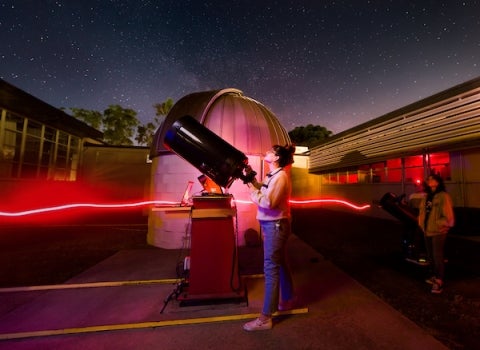College of Science and Math Launches Astronomy Research Fellowship Through Donor Funding
Contact: Nick Wilson
805-235-8008, nwilso28@calpoly.edu
Program Will Provide Faculty and Students with Dedicated Time and Resources for Learn by Doing Projects; First-year Research Will Concentrate on Identifying Ages of White Dwarf Stars
SAN LUIS OBISPO — A new Astronomy Faculty Research Fellowship in Cal Poly’s College of Science and Mathematics will expand opportunities for faculty and student collaborations on space science.

The program is supported by a generous donation from the Marrujo Foundation, established by Dan (Electrical Engineering, ’08) and Rosamaria Marrujo, who live in Roseville, Calif., near Sacramento.
The fellowship, which has been funded for three years, relieves faculty from teaching duties so they can work more closely with students on research.
Elizabeth Jeffery, a Cal Poly assistant professor of physics, will lead the research in the first year. The work begins this spring using scientific methodology to study the ages of stars. She’ll soon begin actively recruiting a research team of students, who will explore data related to locations and brightness of stars to better understand how long they’ve existed.

Jeffery’s research will focus on white dwarf stars, which represent the endpoint of a low mass star’s life. Near the end of its nuclear burning stage, this type of star expels most of its outer material, creating a planetary nebula. Only the hot core of the star remains. Like other stars, the sun will eventually become a white dwarf; experts say that could be in 5 billion years.
“We can learn a lot from white dwarfs and use them to measure star ages,” Jeffery said. “The analogy I like to give is if you’re out camping, the coals glow bright right after you take them out of the campfire because they’re hot, and then their brightness fades as they cool. As time passes, white dwarf stars also get cooler and, as a result, become fainter.”
A white dwarf star cools down at a predictable rate over perhaps a billion or so years; its brightness helps determine how old it is and how long it has been cooling.
Jeffery said these stars are like the fossil remnants of the galaxy — a valuable resource for a kind of astronomy archaeology or paleontology.
Jeffery and her students will use open-source data gathered by the satellite Gaia — a European Space Agency space observatory that launched in 2013— on a 12-year mission to create a precise three-dimensional map of more than a billion stars throughout the Milky Way galaxy and beyond, charting their motions, luminosity, temperature and composition.
“It’s a big project that will need to be accomplished in phases, and having a good chunk of time is valuable,” Jeffery said. “We’re thrilled to have this funding to be able to do this work.”
Additional Cal Poly astronomy faculty focusing on different research are expected to participate in the fellowship in the second and third years of the pilot partnership.
The Marrujo Foundation supports and works with educational institutions to further research in astronomy, astrophysics and cosmology to establish a world-leading fellowship ecosystem. The foundation’s efforts aim to ensure that institutional work challenges current understanding of space, creates new opportunities and makes a difference in people’s lives across the U.S. and around the globe.

Observatory: Cal Poly students host a public viewing night at the on-campus observatory
“The intent here is to create an ecosystem that strengthens the core of what Cal Poly is doing,” said Dan Marrujo, president of Trusted Strategic Solutions, a Silicon Valley-based consulting and government relations firm. “We’ll use world-renowned resources, from space telescopes to satellite data collection. I want students to be excited about this opportunity to pursue their passion.”
Marrujo holds a master’s degree in materials engineering and a bachelor’s degree in electrical engineering (with a minor in physics) from Cal Poly. He is the former chief strategy officer and former director of the Office of Research and Technology Applications at the Defense Microelectronics Activity, delivering microelectronics solutions to the U.S. Department of Defense.
“Success is built on the people doing the work,” Marrujo said. “We’re just an enabler promoting the exciting Learn by Doing experiences for faculty and students that help propel careers.”
About Cal Poly College of Science and Mathematics
With about 2,800 undergraduate and roughly 280 graduate students, the college offers degrees in biology, chemistry, kinesiology and public health, physics, mathematics, statistics, marine science, microbiology and biochemistry. The college is also home to the university’s undergraduate liberal studies program for future teachers and Cal Poly’s post-baccalaureate School of Education. Embracing Cal Poly’s Learn by Doing mission, the college is an esteemed institution, noted for outstanding undergraduate research and significant student co-authorship participation on scientific journal publications.


